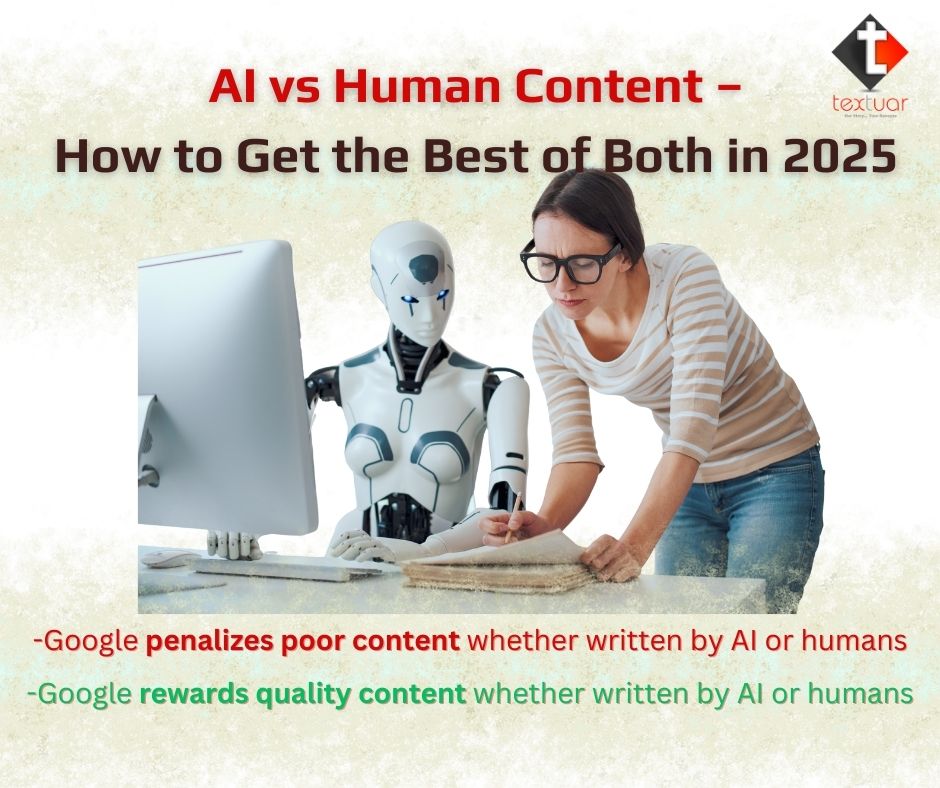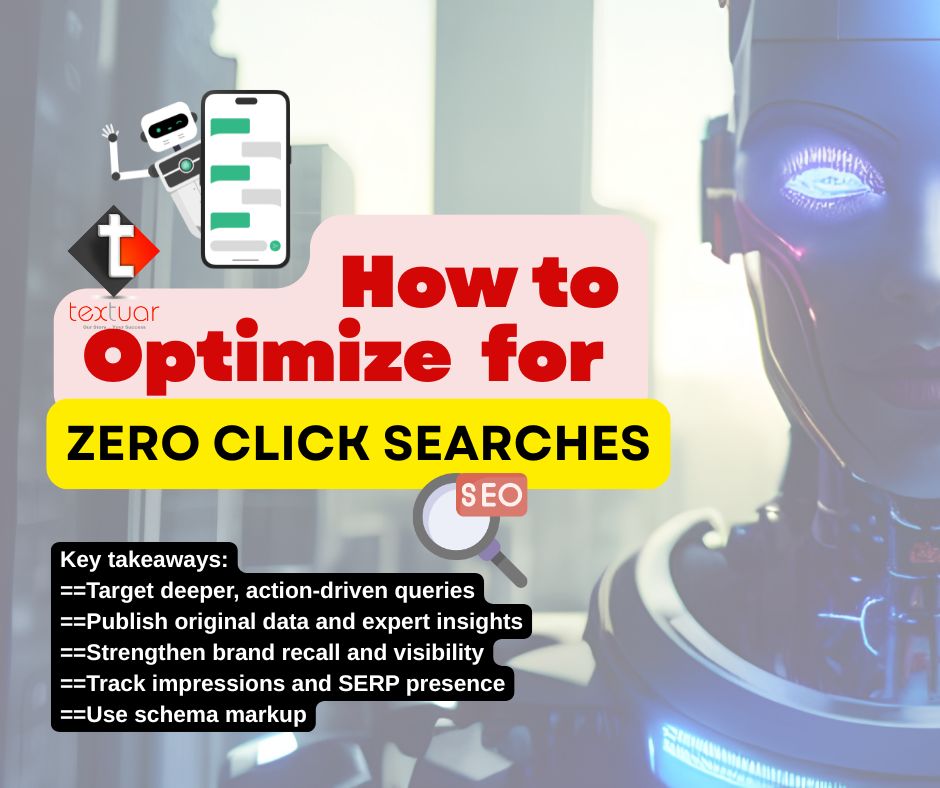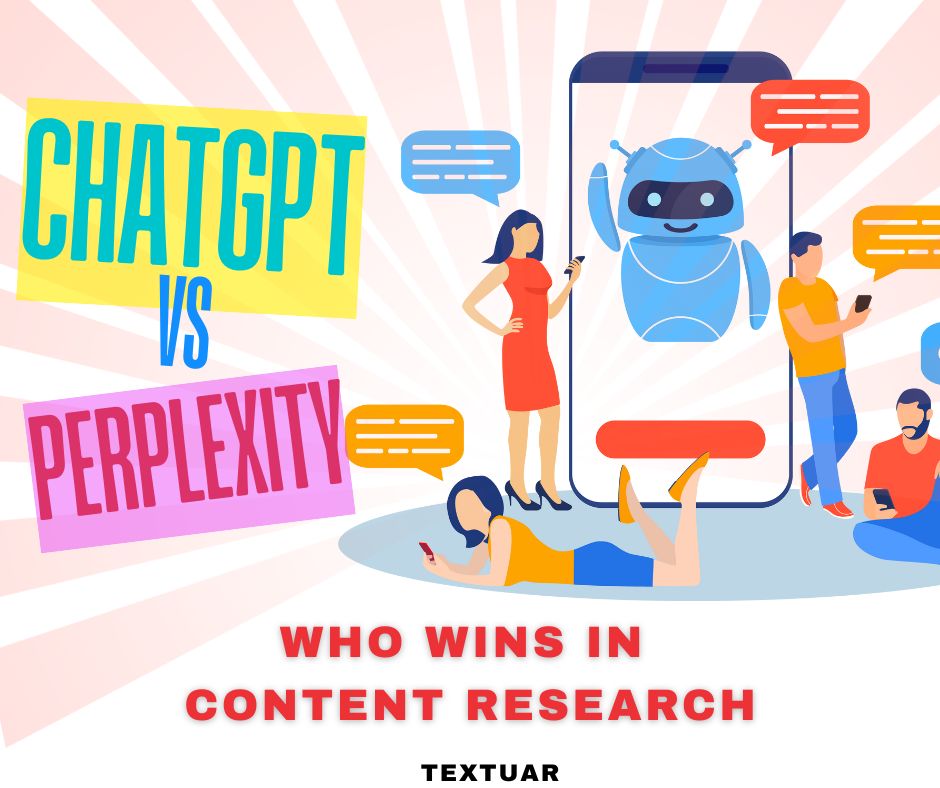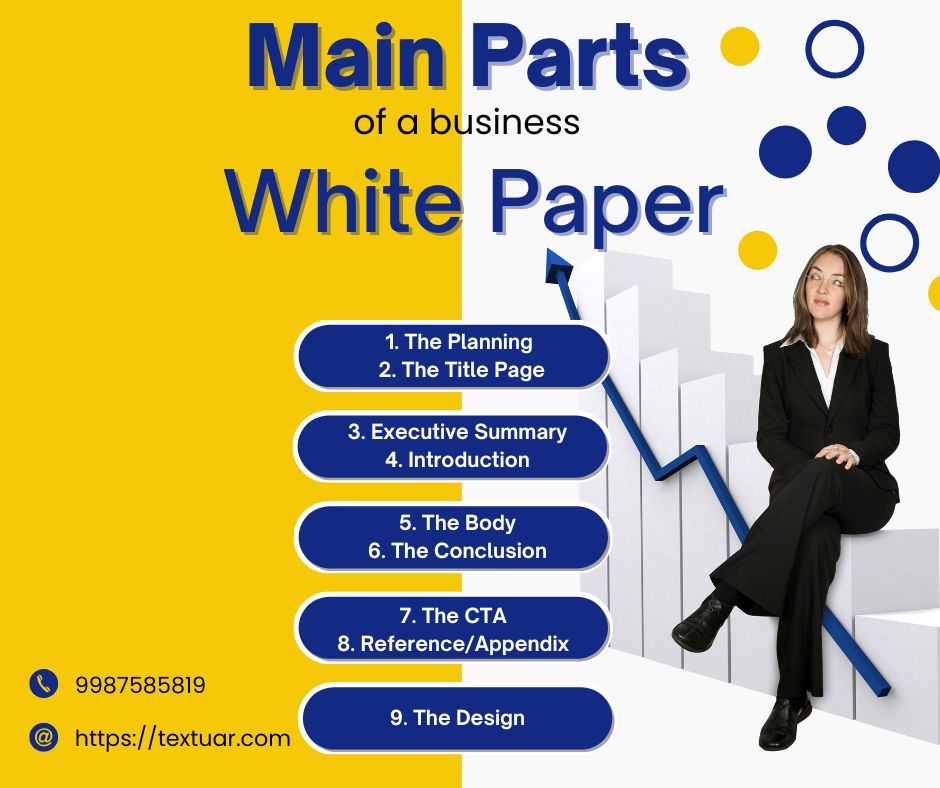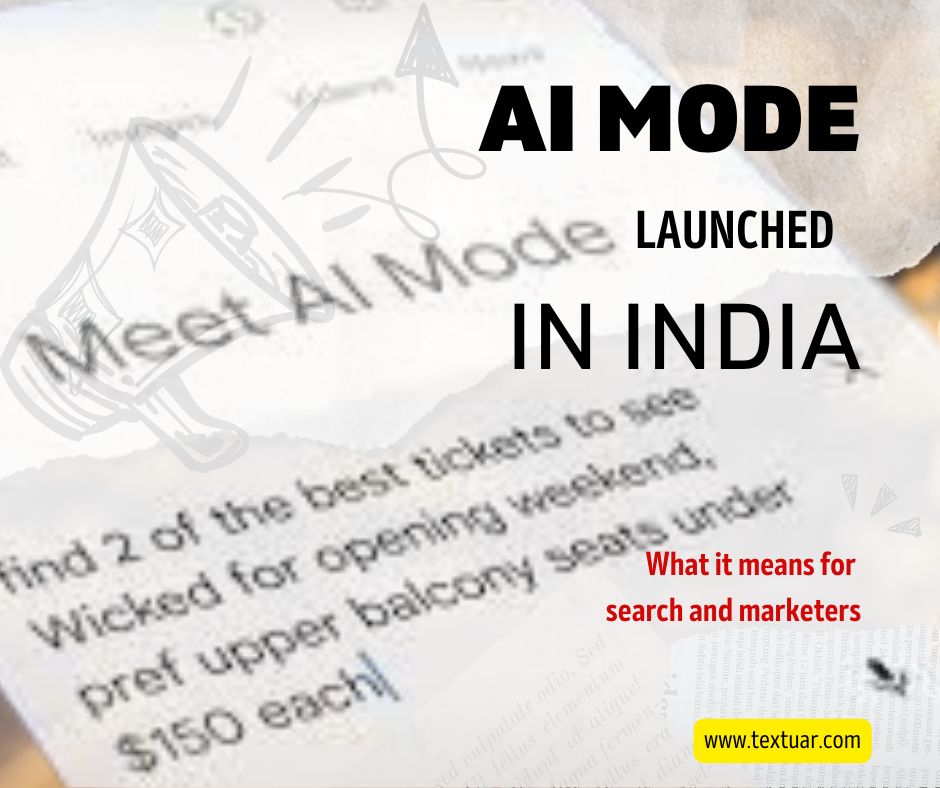📌 TL;DR – Quick Summary
The AI vs. human content debate is missing the point. In 2025, the winning strategy is a hybrid approach, not choosing one over the other.
–Use AI for speed, scale, and data-driven tasks like research and drafting.
–Rely on human writers for emotional connection, creativity, fact-checking, and nuanced storytelling.
This blend ensures content is both efficient and deeply engaging, ranking well on search engines while building audience trust. The key is leveraging each for their strengths, not choosing one exclusively. Contact Textuar for content writing services.
You might probably be weighing whether to use AI to write your next blog post, or hire a human writer. The truth is that each has real strengths and drawbacks.
While generating content at scale with AI looks a good idea, from a marketing perspective, many cases studies have come up that show the disaster that follows after a temporary spike in ranking.
Also, AI content’s credibility diminishes a lot – a fact corroborated by stats like 74% of US adults aged 50+ say they have little to no trust in healthcare information provided by AI.
On the other hand, with purely human approach, the drawbacks would be a slow content pipeline. The time taken to choose topics, ideate on it, create an outline, and QC check the draft is high.
So, which approach to use for your content needs?
You need to understanding those will help you choose the right approach so your content engages readers, ranks well, and supports your brand voice. Let’s explore how AI vs human content writing differ in five key ways.
Factors to Consider When Choosing Between AI Writing vs Human Content
When choosing between AI vs human content, you need to look beyond speed or cost. Each option brings different qualities, tone and credibility to your writing. AI tools can deliver efficiency and scale, while human writers provide depth, cultural awareness and emotional connection. Understanding the distinctions ensures your content will resonate with your brand voice, meet audience expectations and achieve the results you desire.
1. Emotional Connection and Creativity
AI generates ideas and rough drafts at great speed, but is weak in nuance. Human hands use subtleties- humor or irony for shifts in emotion. Consider a blog post on mental wellness–AI delivers the facts, but a human will add sensitivity which connects and feels personal.
This kind of emotional depth is crucial to your content’s success in moving people to act or inspiring loyalty in them.
2. Speed and Scale
This is another factor when looking at AI vs human content. AI is very good at producing many drafts of one document within minutes. For example, a commercial website that depends on e-commerce might well want to use this method in bringing thousands of goods it sells to market quickly and systematically.
However, slower, more contemplative human writing often ends up making more appealing authoritative content. Commitment to deadlines by humans brings originality, a variety of narratives and perspicacious angles, all of which are indispensable for campaigns with high income potential.
3. Expertise, Experience and Reliability
AI doesn’t know true data from misinterpretation or error. Facts might be hallucinated or completely inaccurate. In highly regulated fields like healthcare and finance, the consequences are loss of credibility and penal liability.
Human writers do research, check facts and use their knowledge of a particular field. This helps to make sure that their copy–highlights is the truth. This guarantees credibility and gives readers a sense that they can count on you.
4. Consistency of Tone
AI Practice brands its style by referencing the training data. But it might slip up when topics shifts or audience expectations chance. Human writers move fluidly from whitepapers to blogs and social media posts, always keeping you engrossed.
This adaptability keeps your copy for sounding clichéd or mechanical. And that matters because when a brand voice needs to be consistently authentic, coherent and dependable on all platforms. Plus, such human essence in writing builds trust in audiences’ minds.
5. Managing Resources and Costs
AI is cheap to use upfront, but the cost of editing and fact-checking can be more than you bargained for. A skilled human writer might seem expensive, but their high-quality finished work reduces revisions and iterations.
The right choices depend on your goals, budget and risk threshold. If you want quantity for your campaign, go with AI. If quality is more important, then you will have to pay for human input.
How to Use a Hybrid Approach in AI Writing vs Human Writing?
A hybrid strategy is the best of both worlds. Pass the burden of speed, volume, and repetitive work on to AI and let your human writers concentrate fully on creativity, storytelling, and strategic thinking. Efficiency and genuine emotion balance in this approach; your content can not only be fast and optimized but also touch the heartstrings at a stroke and with full identity in line with what we want to communicate to our viewers.
1. Idea Generation and Research
With the help of AI to scour through search data, trending keywords and the content topics of competitors, you provide human authors with insights that can be turned into context and compelling stories.
2. Draft Creation and Refinement
AI creates rough structures of drafts quickly. Human writers then refine the structure, adjust sentences’ cadence, tone and insert examples which make your story persuasive.
3. SEO Optimization
AI recommends the keyword placements and internal links; humans must make sure that it reads readably without over-optimization penalties.
4. Routine Content Handling
For repetitive descriptions or FAQs, let AI do them. Reserve human energies for strategic projects such as thought leadership or campaign content.
5. Quality Control in AI vs human content
Before publication, human editors may check AI-assisted work for accuracy, freshness and voice alignment.
Which Content Tasks can be Done by AI Writing and Which One by Human Writers?
| Role of AI | Role of Humans | Outcomes |
| Generating topic ideas and outlines, as well as keyword lists | Creating narratives with human touch that are meant for an understanding reader | Quicker planning with creative depth |
| Drafting repetitive or formulaic sections that can be composed almost at a glance | With a smoother flow and closer brand alignment than ever | Efficient yet genuine content |
| Suggesting SEO elements such as metadata and internal links | To insure smooth flow and reader engagement | Human-friendly SEO content |
| 4-Writing product descriptions, summaries for your online store or FAQs | Producing the main essays: pieces on thought leadership and storytelling | Balance workload with quality |
| Providing rapid scalability | Ensuring quality control and fact-checking duties are done | Reliable, scalable content production |
Choosing Your Approach: When to Use AI writing, Human Writers (or Both)
Each different situation calls for a different approach. The optimal choice depends on your timetable, content type and the end result. Here are some situations and the right approach to use:
1. Rapid Content Writing Turnarounds at Scale
Use AI to produce drafts in bulk, then have editorial people check those drafts for voice and quality. This will help get the best of AI writing vs human content writing to meet ETA goals.
2. Specialized Content
Use human writers knowledgeable in your industry to write about regulated or technical areas. Use AI to make content outlines, to add points that the writers may have missed.
3. SEO Volume Strategy
Pair human storytelling with AI-driven keyword research for content that ranks and resonates.
4. Brand Identity Content
Human writers should lead in an emotional storytelling age when authenticity is the key concern. Here, AI will be useless.
5. Routine Tasks to Check AI Writing vs Human Content Writing
It is AI that saves time when dealing with product catalogs, summaries or reports. These types of content need merely a small degree of human oversight.
6. Optimizing for Answer Engine Optimization
AEO calls for specialized optimization techniques. Textuar has outlined a few steps to optimize content for AEO in their blog. From multi-modal content to optimizing for featured snippets, there are a few formatting and optimization steps that can be done by human writers.
| When to use AI writing vs human writing — Decision Summary Table | ||
| Situation Type | Use AI or humans? | Outcomes |
| Tight Deadline for Many Posts | AI first, then polish by human | Speed and respectable quality |
| Highly specialized topics | Human only writers | Authority and compliance guaranteed |
| SEO promotion | AI plus human editing | Balances optimization and readability |
| Branding and thought leadership | Human only writers | Trust and authenticity for audiences |
| Formulaic content (FAQs, Descriptions) | AI with human oversight | Saves time and guarantees accuracy |
| AEO Optimization | Human only writers | Future-proofs content for citation on ChatGPT and AI Overviews |
This decision-making framework provides clarity and eliminates futile work with mismatched resources. It guarantees projects deliver value aligned with the goals using the best of AI writing vs human content writing.
Hybrid Content – The Best Approach in AI vs Human Content
The debate between AI and human authors so often misses the point. The real strength comes when they work side by side.
–AI offers unparalleled speed, data analysis and consistency
–Humans bring empathy, context and originality.

Together they can create content that is efficient and deeply engaging. This approach not only keeps pace with today’s demands, but also lays the groundwork for strategies ready to evolve along with the future. It also leads to better user satisfaction and meets your scalability and technical SEO goals.
The most successful strategies combine AI efficiency with human artistry. This is why blending both is the future of content marketing.
1. Accelerated Research and Insights
AI sifts through thousands of pages to tease out patterns and trending keywords. Humans then take that data and compose emotional insights which resonate with audiences and brands.
The combination saves time on research as well as meaning delivered. Brands can respond to market needs and maintain depth.
2. Consistency at Scale without Bland Narratives
AI ensures consistent tone, formatting and grammar across vast content libraries. Human reviewers break monotony by adding voice, anecdotes and vivid expressions.
Readers sense consistency without getting bored. This way scaling content output does not result machine-like repetition but still keeps a sense of identity and involvement.
3. SEOs That Work for People and Search Engines
AI is good at the technical side of SEO- internal links, metadata and schema. Humans then concentrate on titles that grab attention, story-telling and conversational flow.
Together they build content that ranks for ChatGPT and search engines while delighting readers. This mixed approach ensures search engine visibility and audience loyalty.
4. Stronger Engagement with Your Audience
Stories, analogies and humor need human discernment. AI can help by bringing forward data and context for the narrative. When both combine, you get content that not only informs but entertains, holding its own in competitive arenas for attention.
Emotional content sticks, while AI assures that the facts back up what was said.
5. Faster Iteration and Updates
AI can quickly update old blogs, generate alternative versions, and summarize reports. However, human writers ensure new contexts relevance and style consistency.
Speed like this lets you respond to the market quickly. Audiences notice when content is fresh and this dual-mode approach speeds the work of updating content for your brand.
6. Error Reduction and Reliability
Now and then, AI presents outdated or hallucinated information. Human editors doublecheck confirmation and add trusted citations. Blending the two produces accuracy with a trust that builds brand credibility at a time when credibility is everything.
Companies that give importance to trust and ethics will profit in terms of customer loyalty and search engine visibility.
7. Future-Ready Flexibility
AI obtains emerging keywords and the questions people are presently asking. Human writers adapt their style as culture shifts and audiences’ expectations change. This fusion makes certain that your content is always up-to-date, authoritative and still resonant.
The result is a winning strategy which thrives in the future as well as today.
Why Textuar is the ideal choice for AI-sped and human-led content creation?
The combination of AI and human creativity, no doubt, is the future in content marketing. But to be successful, you need a competent content partner. A reliable company like Textuar knows how to use both and yet not lose what makes your brand unique.
At Textuar, our team excels in this hybrid approach. By using state-of-the-art AI tools in combination with highly skilled human authors, we deliver content which is efficient, authentic, and fits your strategy goals.
At Textuar, we believe the best content arises when humans lead and AI supports.
Our systems balance efficiency with creativity in a way that no pure-AI service can.
Here’s why Textuar is your choice of content partner for AI vs. human content creation:
1. Expert Writers with Domain Insight
We produce engaging and accurate content focusing on the audience across industries.
2. Hybrid Workflow in AI vs Human Writing for Quality
AI accelerates drafting, but it is our human writers who refine, fact check and personalize. Every piece passes through several rounds of review from our end.
3. SEO-Driven & Human-Friendly
We optimize for search engines while making sure there is readability and engagement for your audience
4. Scalable Yet Personalized
Whether you need ten blogs or a hundred, your brand voice remains intact and consistent. Our writers shall see to it this uniformity remains true for every content asset.
5. Collaborative and Transparent
Our writers keep you involved right the way through, from draft to final delivery. This guarantees that what is delivered matches what you expect.
Conclusion
AI content writing and human writing are not competitors, but partners. The smartest brands use both. They applying AI for speed and efficiency. They trust human writers for depth, empathy and reliability.
A good content expert like Textuar would know when to use what approach. This way, they create content that ranks as well as captivates attention.
These reasons position us front and center as a content writing agency that will serve your marketing needs in this AI era. Contact us to know about our content writing capabilities.
FAQs
1. Can AI-generated content hurt SEO ratings?
Yes, if it is repetitive or superficial. Google favors informative, people-oriented content with real value. For instance, the process tuning up of AI drafts needs human editing to ensure they meet quality control standards. Such content has genuine quality, not just random words.
2. How much editing do AI drafts need to undergo?
That varies. For general subjects, a light polishing might be sufficient. But when it comes to technical or brand sensitive materials then deeper revision with a line-by-line check is needed if you want accuracy and credibility.
3. Is hybrid content more cost-effective than doing a human write job?
Yes. The pace AI provides for creating content is fast, while also cutting costs. But human supervision is needed to ensure quality. This way, you can strike a balance between speed and standards.
4. Will my audience notice if I use AI?
Perhaps they will detect generic language or context is off. With human editing, however, AI-generated content tends to read naturally. The reader cares more about clarity, trustworthiness, or helpfulness rather than thinking who created the content.

